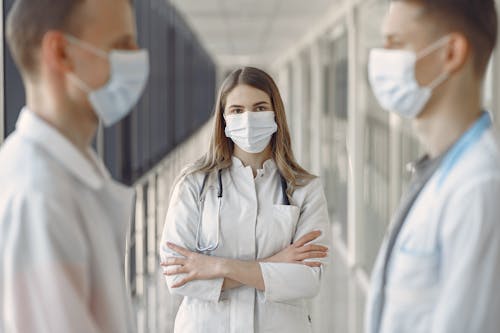
Endometriosis is a painful gynaecological condition where tissue similar to that which normally lines the inside of a woman’s uterus grows outside her uterus. Every woman who has experienced menstrual cramps or dysmenorrhea knows how uncomfortable it can be. Studies show that 84.1% of women suffered from period pain at some point in their lives. Unfortunately, painful menstrual cramps can occur every time you have your period, beginning in your teens at the onset of menarche (first menstruation) all the way to menopause.
For most women, this typical pain in their abdomen occurs during the first day of their menstrual period. They can often alleviate the discomfort with normal over-the-counter pain relievers and a heating pad. However, for 5-10% of women, this pain can be debilitating enough to disrupt their daily life. If this excruciating pain keeps you from performing your daily activities, you may be experiencing something different from regular menstrual cramps.
You may be experiencing Endometriosis.
What Exactly is Endometriosis?
Endometriosis is a very painful gynaecological condition that happens to approximately 2 – 10% of women. The name of this condition comes from the word “endometrium,” which is the tissue that lines the uterus.
This condition occurs when similar tissues that normally line the endometrium (or uterus) grow outside the uterus. This tissue commonly develops in the pelvic area and other areas such as:
- Fallopian tubes
- Ovaries
- The tissue lining the pelvis
- Outside the uterus
- In rare cases, this endometrial-like tissue can also develop in other areas like the heart, lungs, and digestive tract

This endometrial-like tissue responds to your menstrual cycle, too, causing thickening of linings, breaking down, and bleeding. However, unlike real endometrial tissue that gets expelled from your body in menstruation, endometrial-like tissue outside the uterus does not flow out and is trapped in the area.
As a result, the waste tissue and blood remain in the body, leading to inflammation. When the tissues decompose within you, you can expect severe pain. Though this waste tissue is not cancerous, it can cause lesions, scars, and adhesions. In addition, it can eventually block your fallopian tubes.
Moreover, you can develop cysts in your ovaries (endometriomas) or other parts where the blood is trapped. Eventually, your tissues can fuse and alter the state of your reproductive organs, impacting your fertility.
Endometriosis can severely impact your quality of life. If you suspect you suffer from it, consult your gynecologist for treatment.
Signs and Symptoms of Endometriosis
The number one symptom of endometriosis is pain in the pelvic area. It is often associated with menstrual periods. Many women suffering from this disorder say that they have unbearable cramps and unusual bleeding during their periods. Pain is severe, radiating from the abdomen to the lower back, and can intensify with time.
If you feel these during your menstruation, it could be an indicator that you have endometriosis. There are several signs that show what you are experiencing is not usual menstrual pain. Assess the following:
- Do your period cramps prevent you from engaging in normal daily activities?
- Do you vomit or feel nauseated when severely painful cramps strike?
- Are you suffering from excessively heavy bleeding with your cramps?
On top of that, endometriosis may let you feel pain the week before your menstrual period begins. This pain will last for your entire period or even extend until a few days later. You can also experience severe bleeding. Take note if your period exhibits the following:
- Heavy period days last more than one week
- Changing your sanitary products every hour
- Normal pads cannot prevent leakage
- Frequent passing of blood clots that are bigger than a quarter
Apart from painful periods, you can also experience pain during vaginal intercourse if you have endometriosis. Some women also experience bloating, fatigue, nausea, and discomfort with urination or bowel movements. Additionally, those with endometriosis sometimes experience irregular periods or spotting in between cycles.
If you suffer from this kind of excessive bleeding and pain, you do not have to endure it. Instead, visit a gynaecologist to find out the source of your problems. Aside from testing, you can also trace your family medical history because endometriosis affects members of the same family.
Thus, if your sisters, mom, grandma, cousins, or aunts suffer from this condition, you could have it, too. Endometriosis is a genetic condition that could be inherited from your maternal or paternal family line. Staying informed and knowing your disease risks can help you make lifestyle changes and medical decisions.

Diagnostics and Treatments for Endometriosis
Typically, treating period pain is simple with OTC pain meds, heating pads, and gentle stretching exercises like yoga to relieve the cramps. However, endometriosis requires more intensive help, especially for women who cannot find pain relief from the usual remedies.
Your gynaecologist will perform a physical pelvic exam to feel for scar tissue and signs of cysts. Additionally, you may be required to get the following procedures:
- Pelvic Ultrasound: They use a device emitting high-frequency sound waves to take an internal picture of your reproductive organs. Typically, they insert a transducer or vaginal ultrasound machine to check your uterus.
- MRI: Magnetic resonance imaging can take a clearer picture of your body than an x-ray. The magnet, radio waves, and computer provide a better condition of what goes on inside your body. This will help your doctor assess your condition, especially if you need surgery.
- Laparoscopy: The doctor will perform a keyhole surgery or make a small incision near the belly button. Then a laparoscope or very tiny device with a camera is inserted to check for signs of endometriosis.
You can also find out your genetic risk for conditions like endometriosis by taking a DNA test.
Your doctor will work with you based on the severity of your condition. Possible treatments can include the following:
- Hormone therapy
- Prescription Danazol to slow endometrium growth
- Surgical removal of excess endometrial tissue outside the pelvic area
- Severe cases may require a radical hysterectomy (taking out the uterus)
Remember, the sooner you get an official diagnosis, the sooner your gynaecologist can help you make a treatment plan to address your symptoms. If left untreated, endometriosis can lead to infertility. Thus, it is imperative to seek help in the early stages to prevent escalations.
Endometriosis is manageable if you get tips from your gynecologist about how to deal with it. You might try certain exercises, massage or aromatherapy. Your gynaecologist will likely encourage you to experiment with different pain management methods. Like any type of chronic pain, endometriosis can be more manageable if you find a coping strategy that works for you.







Comments are closed.